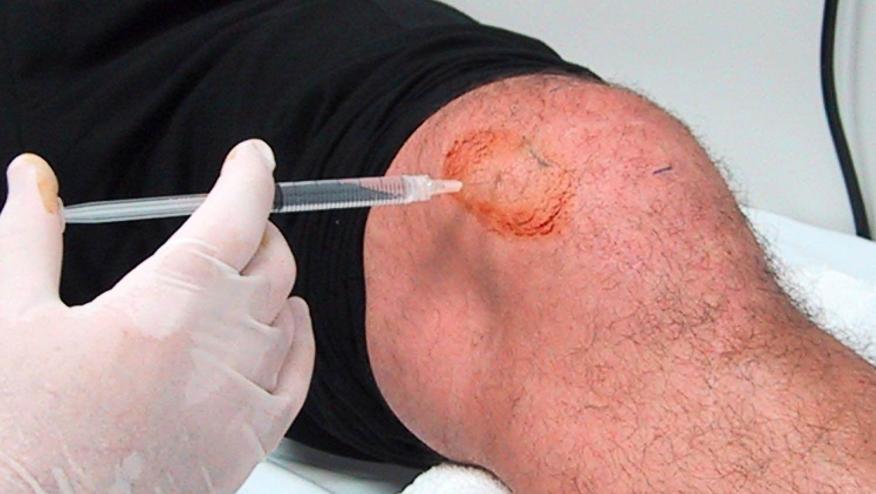Effect of Intraarticular Steroid Shots on Knee OA Outcomes Save

In patients with osteoarthritis (OA) of the knee, intra-articular injections of steroids did not increase rates of either disease progression or subsequent knee replacement surgery, researchers said.
Among more than 560 OA patients in a long-running French cohort, 6.0% of those receiving steroid injections underwent knee replacement within 5 years, compared with 6.4% of patients whose knees went untreated, according to Augustin Latourte, MD, PhD, of the University of Paris, and colleagues.
That worked out to a hazard ratio of 0.92 (95% CI 0.20-4.14, P=0.91), the group reported in Arthritis & Rheumatology.
There was a slight trend toward higher rates of worsened pathology following the steroid injections, as indicated by increasing Kellgren-Lawrence grade, but it did not reach statistical significance (HR 1.33, 95% CI 0.64-2.79, P=0.44).
Similar results were also seen for intra-articular injections of hyaluronic acid, with hazard ratios of 0.81 (95% CI 0.14-4.63) for knee replacement and 1.36 (95% CI 0.85-2.17) for worsening of Kellgren-Lawrence grades.
Overall, Latourte and colleagues called the results "reassuring" and concluded that "in a real-life setting cohort of patients with symptomatic knee OA, we found that patients treated with [steroid] injections were at similar risk of [knee replacement] or radiological progression over 5 years [versus] untreated patients."
Given the study's substantial limitations, however, the researchers added that the findings "need to be replicated in other cohorts."
Their study came about because of ongoing debate in the orthopedic community about the potential risks with steroid injections. Several studies had pointed to the possibility of accelerated cartilage loss with prolonged intra-articular steroid treatment. A 2017 paper in JAMA, reporting a 140-patient randomized trial, indicated that repeated steroid injections provided "no significant difference in knee pain" and led to reduced MRI-measured cartilage volume relative to a placebo group. A 2019 retrospective analysis involving 648 patients yielded similar findings, as had a number of studies in animal models.
But those results weren't definitive, Latourte and colleagues argued, because the clinical studies only lasted 2 years and the randomized trial administered injections every 3 months for the full study duration, a relatively intense regimen. Hence, they believed that examining an established cohort for a longer period of time would shed more light on the issue.
In particular, they drew on participants in the Knee and Hip Osteoarthritis Long-term Assessment study, which involves a total of 878 patients in France with Kellgren-Lawrence grades of at least 2 at enrollment. The 564 included in the current analysis were those with knee OA and at least 5 years of follow-up.
Of these, 414 had no intra-articular injections, 51 received steroid shots, and 99 had hyaluronic acid injections. Mean numbers of injections were 1.9 (SD 1.4) for steroids and 2.2 (SD 1.6) for hyaluronic acid over the 5-year span.
Patients receiving injections did differ considerably on average from those whose joints were not treated. At baseline, those getting injections had generally more advanced OA (e.g., about 40% had Kellgren-Lawrence grade 4, versus 21% of the untreated controls), and reported more pain. Women were slightly more common among the injection groups.
On other parameters, including Western Ontario McMaster Universities Osteoarthritis Index score, painful joint counts, and overall health status, those receiving injections were similar to controls. Statistical analyses were adjusted for propensity estimates regarding the likelihood of the primary outcomes; those with baseline Kellgren-Lawrence grades of 4 were excluded in the analysis of disease worsening.
During follow-up, 59 patients required knee replacement. This relatively small number -- about 10% of the overall sample -- and the fact that some 80% of the cohort had no injections were the reason for the statistical results' very broad confidence intervals. Thus, a genuine detrimental effect from the shots couldn't be ruled out.
Other limitations included the study's retrospective nature, its reliance on Kellgren-Lawrence grades as the measure of disease worsening (these do not correlate perfectly with joint space narrowing, for example), and its conduct in France with its unique sociodemographic mix. Additionally, records of injections may not have been fully accurate.








If you are a health practitioner, you may Login/Register to comment.
Due to the nature of these comment forums, only health practitioners are allowed to comment at this time.